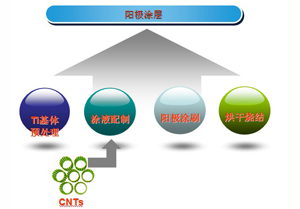本文采用热分解法制备Ti/Ru-Ir-Sn氧化物阳极,运用TGA、SEM、EDS、循环伏安、电化学交流阻抗、极化曲线以及强化电解寿命测试方法,探讨添加不同含量碳纳米管(CNTs)对Ti/Ru-Ir-Sn氧化物阳极的影响规律. 热重分析和阳极能谱数据表明,在烧结温度470 oC条件下CNTs未发生高温氧化分解,仍以单质形式存在阳极涂层中. 与对比样品相比,涂层表面裂纹增多,但仍保持典型形貌. 添加CNTs显著改善了Ti/Ru-Ir-Sn氧化物阳极的电化学性能,增大了阳极的活性表面积,减小了涂层内部电阻,提高了阳极析氯电催化活性,析氯电位增加缓慢,阳极强化电解寿命也得到明显延长. 其中,添加0.1 g·L-1 CNTs的Ti/Ru-Ir-Sn氧化物阳极电催化活性和稳定性最优.
The Ru-Ir-Sn metal oxide anodes coated on titanium (Ti/Ru-Ir-Sn) were prepared by thermal decomposition. The effects of amounts of carbon naotubes (CNTs) on anodic properties were studied by TGA, SEM, EDS, cyclic voltammetry, EIS, polarization measurements and accelerated life test. The thermogravimetric analysis and EDS spectrum data showed that the high temperature oxidation decomposition of CNTs did not take place under the condition of the sintering temperature of 470 ℃, and the CNTS still existed in the anode coating in an element form. Compared with the contrast samples, the surface crack of the coating increased, but remained typical morphology. Adding the CNTs significantly improved the electrochemical properties of Ti/Ru-Ir-Sn oxide anodes, enhanced the active surface area of the anode, and reduced the internal resistance of the coating, which improved the electrocatalytic activity of the anode toward chlorine evolution, thus, the chlorine evolution potential increased slowly, and the accelerated life was also apparently improved. Particularly, the Ti/Ru-Ir-Sn oxide anode adding 0.1 g·L-1 CNTs exhibited the best anodic electrocatalytic activity and stability




